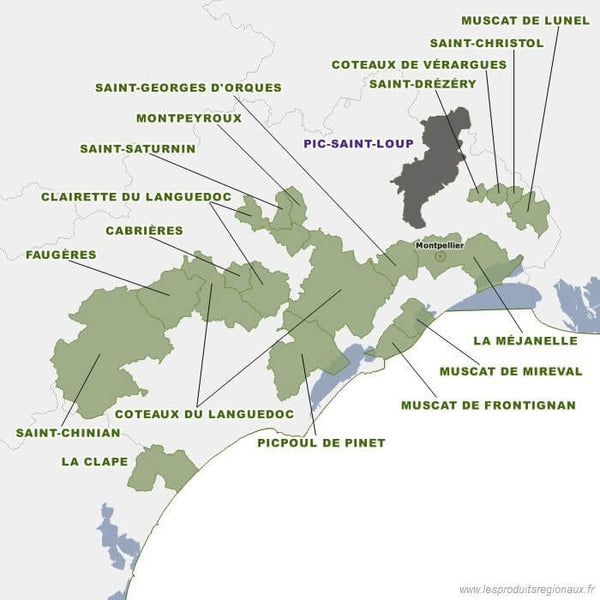Located within the Languedoc-Roussillon , the Pic Saint Loup appellation is one of the most renowned in its region and in France. However, and although its origins date back to the beginning of our era, its creation as an independent entity is very recent.
But then why do his wines fascinate so much? enthusiasts? What are the terroirs and grape varieties of this appellation? ? What to expect during tasting ? Through this article, we will explore all these questions.
Happy reading!
History and creation of the AOC Pic Saint Loup
Although introduced into France before our era by the Phocaeans , the vine and its cultivation first developed in the Languedoc region thanks to the Roman Empire . Then, when he fell, it was the monks which will help to partially save the decline of the Languedoc vineyards, and this until the Middle Ages.
Well, it's not really that from the 19th century that the monoculture of vines will develop significantly in the Pic Saint Loup area. It is also at this time that wines will begin to be exported to the rest of the region, then throughout France and abroad.
The recent history of Pic Saint Loup therefore begins in 1931 with the creation of the Pic Saint Loup wine union , then grouping together only 6 municipalities. Then, in 1955 , the wine-growing area is recognized in VDQS (Superior Quality Wine), the ancestor of our current AOC or AOP system. During this year and the next, 7 additional municipalities will come then add to the production area. The story continues in 1960 , when 13 VDQS in the region were grouped together to form just one: the hillsides of Languedoc.
In 1994 , Pic Saint Loup then becomes a geographical name within the Coteaux-du-Languedoc, therefore having specifications specific to its area. Finally, Pic Saint Loup will officially become an independent AOC in 2017 , 16 years after making the official request!
Although its history is distant, rich and evolving, Pic Saint Loup has only been a fully-fledged AOC for a very short time. !
Climate and terroirs of the AOC Pic-Saint-Loup
Today, the name Saint Loup Peak account 1 300 hectares spread over 17 municipalities. These are located approximately 15km north of Montpellier and 30km from the Mediterranean coast, thus benefiting from multiple climatological influences.
In fact, the Northern continental freshness here mixes with the southern Mediterranean heat . Summers are therefore hot and dry, springs are cool, while autumn and winter are cold and rainy.
This mixture of climates gives the vineyard large temperature variations between day and night, allowing optimal ripening of the grapes : between richness and freshness.
In addition, due to their proximity to Pic Saint Loup, the vines here are well-known high rainfall for the region (1000 mm per year on average compared to sometimes half as much a few kilometers away).Its terroir is therefore the most watered in the entire Languedoc region. ! Finally, the vines are here relatively protected from the winds , although Mistral and Tramontane can sometimes be felt.
From a soil point of view, Pic Saint Loup has particularly calcareous soils , also composed of dolomites and marls. This type of soil promotes the water retention , thus allowing the vine to not experience water stress and to ideally nourish its grapes.
As you will have understood, the climatic and terrestrial particularities of the region contribute to the typicality of the Pic Saint Loup wines. These latter in fact directly shape their aromatic expression and the region therefore has many natural assets to produce exceptional wines .
The wines of the AOC Pic-Saint-Loup
On Pic Saint Loup, near 90% of production is dedicated to red wines , the rest being vinified as rosé. The grape varieties Syrah , Grenache And Mourvèdre are the three key pieces here and must represent at least 90% of the grape varieties in a red wine. The aromatic seduction of Syrah thus blends with the sweetness of Grenache as well as the structure and power of Mourvèdre in a very complementary blend.
Other varieties such as the Cinsault , THE Carignan or Counoise can also be used but must not exceed 10% of the total.
But then, what to expect during the tasting? ? Although very different profiles can arise depending on the blend chosen by the winemaker, the quality of the vines or their altitude and exposure, the appellation is recognized for producing red wines benefiting from superb aromatic balances oscillating between power and freshness .
Therefore, notes of red and black fruits are regularly present (blackberry, blackcurrant, cherry, strawberry, raspberry), accompanied of garrigue aromas (thyme, rosemary, menthol, bay leaf) - which are often found around vines - as well as a peppery touch . Depending on the breeding chosen by the winemaker (stainless steel vat, tuna, barrel, etc.), woody notes and vanilla may also make their appearance.
Some winemakers are turning to a "traditional" style, offering wines rather tannic and oriented towards power. Others, will be interested in the purity of the fruit as well as the search for elegance.
Finally, the rosé wines from Pic Saint Loup are generally fresh, gourmet and marked by notes of red fruits.
What dishes with a Pic-Saint-Loup ?
What are the best Pic Saint Loup ?
- The Owl of the Cellar - Pic Saint Loup - Nothing scares me
- The Owl of the Cellar - Pic Saint Loup - Nothing scares me MAGNUM
- The Owl of the Cellar - Pic Saint Loup - A beautiful novel, a great story
- The Owl of the Cellar - Wine of France - Self-portrait
Conclusion
As you will have understood, the Pic Saint Loup wine appellation has magnificent assets and that is why its wines often have a special place in the hearts of red wine lovers .
Between limestone soils , oscillating climates between northern freshness and Mediterranean warmth as well as its very complementary triptych of Syrah-Grenache-Mourvèdre grape varieties , Pic Saint Loup is a fabulous playground for producing wines of remarkable quality.
All you have to do now is go and discover it! ! For this, and if you need advice, do not hesitate to call on The Illuminated Cellar !









